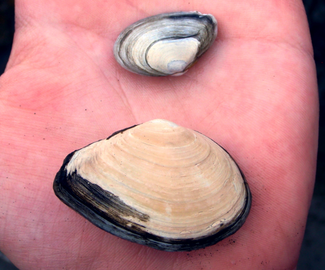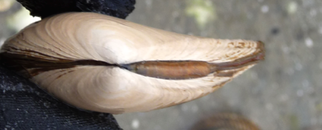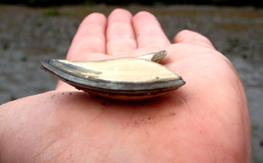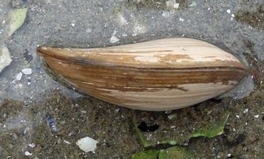Bent-nose macoma • Macoma nasuta
Identification
The bent-nose macoma can be distinguished by the rightward bend in the elongated portion of its shell valves (click here for information on shell orientation). This bend can vary in severity, though it is usually fairly sharp. The shell is thin and chalky white, usually unstained, and with edges partially covered by grey-brown periostracum. This clam's siphons are long, orange, and separate. Its shell reaches 7.5 cm in length.
Habitat & Range
The bent-nose macoma is a common species in sandy, gravelly, and muddy intertidal areas to a depth of 50 m. It lives buried 10-15 cm below the surface. Its range extends from Kodiak Island, Alaska to southern Baja California.
Similar Species
The bend in this species' shell makes it relatively easy to distinguish from other Macoma species, which usually also have thin white or whitish shells.
Intriguing Info
Moonsnails (e.g. Euspira lewisii) prey on the bent-nose macoma - the shells of this species are often found with a hole near the hinge.
The bent-nose macoma filters a large amount of sediment and is often found in areas with bad circulation, making it a poor harvest species.
The bent-nose macoma can be distinguished by the rightward bend in the elongated portion of its shell valves (click here for information on shell orientation). This bend can vary in severity, though it is usually fairly sharp. The shell is thin and chalky white, usually unstained, and with edges partially covered by grey-brown periostracum. This clam's siphons are long, orange, and separate. Its shell reaches 7.5 cm in length.
Habitat & Range
The bent-nose macoma is a common species in sandy, gravelly, and muddy intertidal areas to a depth of 50 m. It lives buried 10-15 cm below the surface. Its range extends from Kodiak Island, Alaska to southern Baja California.
Similar Species
The bend in this species' shell makes it relatively easy to distinguish from other Macoma species, which usually also have thin white or whitish shells.
Intriguing Info
Moonsnails (e.g. Euspira lewisii) prey on the bent-nose macoma - the shells of this species are often found with a hole near the hinge.
The bent-nose macoma filters a large amount of sediment and is often found in areas with bad circulation, making it a poor harvest species.
References
Cowles, D. (2005). Macoma (Heteromacoma) nasuta (Conrad, 1837). Invertebrates of the Salish Sea. Rosario Beach Marine Laboratory. Accessed 02/09/2013.
Harbo, R. M. (1999). Whelks to whales: Coastal marine life of the Pacific Northwest. Madeira Park, BC: Harbour Publishing. P. 95.
Ingram, D. (2010). Getting Your Nose Bent out of Shape. Island Nature. Accessed 02/09/2014.
Authors and editors of page
Kelly Fretwell and Brian Starzomski (2014).
Cowles, D. (2005). Macoma (Heteromacoma) nasuta (Conrad, 1837). Invertebrates of the Salish Sea. Rosario Beach Marine Laboratory. Accessed 02/09/2013.
Harbo, R. M. (1999). Whelks to whales: Coastal marine life of the Pacific Northwest. Madeira Park, BC: Harbour Publishing. P. 95.
Ingram, D. (2010). Getting Your Nose Bent out of Shape. Island Nature. Accessed 02/09/2014.
Authors and editors of page
Kelly Fretwell and Brian Starzomski (2014).







